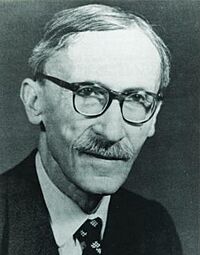Paul Lévy (mathematician) facts for kids
Quick facts for kids
Paul Lévy
|
|
|---|---|

Paul Pierre Lévy
|
|
| Born | 15 September 1886 |
| Died | 15 December 1971 (aged 85) |
| Nationality | French |
| Alma mater | University of Paris |
| Known for | Additive process Brownian excursion Concentration of measure Martingale (probability theory) Universal chord theorem Lévy alpha-stable distribution Lévy's arcsine law Lévy C curve Lévy's constant Lévy characterisation Lévy's continuity theorem Lévy distribution Lévy flight Lévy's local time Lévy measure Lévy's modulus of continuity theorem Lévy process Lévy's zero–one law Lévy–Khintchine representation Lévy–Prokhorov metric Lévy–Steinitz theorem Lindeberg–Lévy CLT Wiener–Lévy theorem |
| Awards | Emile Picard Medal of the French Academy of Sciences (1953) |
| Scientific career | |
| Fields | Mathematics |
| Institutions | École Polytechnique École des Mines |
| Doctoral advisor | Jacques Hadamard Vito Volterra |
| Doctoral students | Wolfgang Doeblin Michel Loève Benoît Mandelbrot Georges Matheron |
Paul Pierre Lévy (born September 15, 1886 – died December 15, 1971) was a French mathematician. He was very important in the field of probability theory. This area of math deals with understanding chance and random events. He came up with many new ideas, like "local time" and "stable distributions." Many mathematical concepts are named after him, such as Lévy processes, Lévy flights, and the fractal Lévy C curve.
Contents
Paul Lévy's Life Story
Early Life and Education
Paul Lévy was born in Paris, France. His family had many mathematicians, including his father, Lucien Lévy. Paul went to a famous school called the École Polytechnique.
He published his first math paper in 1905 when he was only 19 years old. This was while he was still a student! His teacher and mentor was a well-known mathematician named Jacques Hadamard.
After finishing school, Paul Lévy served in the military for a year. Then, he studied at the École des Mines for three years. He became a professor there in 1913.
Working During Wartime
During World War I, Paul Lévy used his math skills to help the French Artillery. He did important analysis work for them.
In 1920, he became a professor at the École Polytechnique. Some of his famous students included Benoît Mandelbrot and Georges Matheron. He taught there until he retired in 1959.
However, there was a time when he had to stop teaching. During World War II, he was removed from his job in 1940. This happened because of unfair laws against Jewish people at that time.
His Amazing Contributions to Math
Paul Lévy made many big discoveries in probability theory. This is the study of how likely events are to happen. He also helped create the idea of "stochastic processes." These are mathematical models that describe things that change randomly over time.
He introduced the idea of "stable distributions." These are special types of probability distributions that stay the same even when you add more random variables together. He also proved a general version of the Central limit theorem. This theorem is very important in statistics. He wrote about these ideas in his 1937 book, Théorie de l'addition des variables aléatoires.
Lévy also studied Brownian motion. This is the random movement of tiny particles, like dust in the air. His 1948 book, Processus stochastiques et mouvement brownien, had many new ideas about this. These included the "Lévy area" and the "local time" of a Brownian path.
Awards and Family
Paul Lévy received many honors for his work. He became a member of the French Academy of Sciences. He was also an honorary member of the London Mathematical Society.
His daughter, Marie-Hélène Schwartz, and his son-in-law, Laurent Schwartz, also became famous mathematicians.
Paul Lévy's Books
- 1922 – Lecons d'analyse Fonctionnelle
- 1925 – Calcul des probabilités
- 1937 – Théorie de l'addition des variables aléatoires
- 1948 – Processus stochastiques et mouvement brownien
- 1954 – Le mouvement brownien
See also
 In Spanish: Paul Pierre Lévy para niños
In Spanish: Paul Pierre Lévy para niños
- Lévy distribution
- Lévy process
- Lévy flight
- local time
- Lévy's characterisation of Brownian motion

